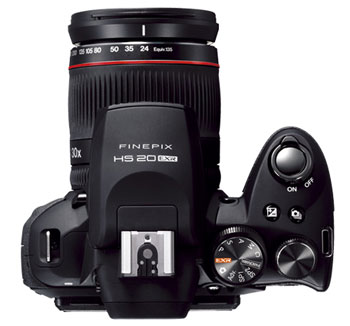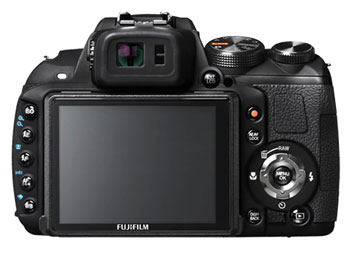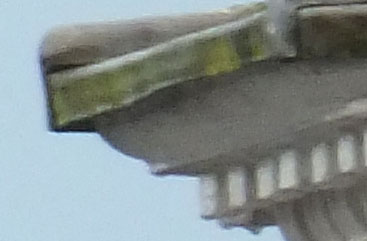Обзор фотокамеры Fujifilm HS30 EXR
Содержание
Особенности камеры
Что необычного в КМОП-матрице? Её скорость. Но это у всех, а у Fujifilm есть и другие плюсы. Для начала матрица FinePix HS20EXR больше, чем у конкурентов — 1/2 дюйма против 1/2,3. Конечно, и максимальное разрешение велико, но, например, у тех же ультракомпактов Sony с КМОП-матрицы размером 1/2,3 дюйма снимаются те же 16 Мп. Однако размер тут не главное, и матрица кардинально отличается от конкурентов. Как утверждает компания, пиксельные и цветовые массивы EXR являются ключом для обеспечения высокого качества изображения. При повороте на 45 градусов пиксельный массив EXR увеличивает как горизонтальное, так и вертикальное разрешение. Использование двойных диагональных пикселей одного цвета позволяет переключать сенсор между режимами HR (высокое разрешение), DR (широкий динамический диапазон) и SN (высокая чувствительность и понижение шумов) в зависимости от съемочного плана для получения высококачественной фотографии в любых условиях. Уникальным свойством сенсора EXR является его способность адаптировать свои настройки в соответствии с выбранным кадром. Три доступных режима отличают его от любых других сенсоров и используются только в фотоаппаратах Fujifilm. В режиме EXR AUTO оптимальные настройки сенсора выставляются автоматически. Камера способна самостоятельно определять 10 типов сюжетных программ, что умеет далеко не каждый аппарат.
Стоит отметить и скоростные режимы съёмки. Камера способна снимать видео со скоростью 80 кадров/с при разрешении VGA, 160 кадров/с при разрешении qVGA и 320 кадров/с при разрешении 320×112 точек. Кроме того, FinePix HS20EXR умеет снимать серии со скоростью 8 кадров/с при полном разрешении и 11 кадров/с при разрешении 8 Мп, разумеется, длительность серии ограничена одной секундой.
Также камера умеет автоматически склеивать панорамные снимки. Перед началом съёмки можно, не заходя в основное меню, быстро выбрать направление движения камеры, а также угол панорамы (120, 180 и 360 градусов). Во время съёмки на экране отображается строка прогресса и линия горизонта, что позволяет при повороте камеры более точно контролировать ее смещение. FinePix HS20EXR не особо требовательна к скорости поворота, возможна даже остановка движения, и ограничение фактически лишь одно — при движении назад, даже на градус, камера автоматически прекращает съёмку панорамы. Конечно, в плане съёмки автоматических панорам герой обзора проигрывает в корректности склейки и разрешении одному из главных конкурентов — Sony Cyber-shot DSC-HX100V, но всё же функция есть и она работает, хотя при работе с камерой с рук (без штатива) корректная склейка панорам выходит далеко не всегда с первого раза.
Fujifilm FinePix HS20 EXR movie modes
The FinePix HS20 EXR’s best quality video mode is 1080p30. Other options include 720p, VGA (640×480) and three high speed movie modes at 80, 160 and 320fps at resolutions of 640×480, 320×240 and 320×112 respectively. There’s a dedicated movie recording button on the back panel and you can shoot 3264×1840 pixel 16:9 stills while recording.
At 1080p the average bitrate is around 14Mbps, so you’ll get around 35 minutes of footage on a 4GB card, the limit for single clips at this resolution is 29 minutes and Fujifilm recommends a Class 4 speed card or faster. You can of course use the manual barrel zoom during movie recording, but if you take a look at the hand-held example below, you’ll understand why that’s a bad idea, more about that and the general handling characteristics of the FinePix HS20 EXR below.
|
|
|---|---|
|
|
|
|
The FinePix HS20 EXR’s best quality 1080p30 video produces pleasant enough results, but it’s impossible to zoom smoothly or hold the camera steady whilst doing so – to be fair this is no different from trying to zoom with a DSLR lens, but it’s worth remembering its super-zoom rivals from Canon, Sony and Panasonic can all smoothly adjust their focal length while filming with their motorised zooms. So there’s definitely pros and cons to having a manual zoom ring.
|
|
|---|---|
|
|
|
|
Even with the camera on a tripod vdeo zooming is a challenge best avoided. Apart from the jerking around, the Finepix HS20 EXR’s autofocus loses track and takes a fair while to pull things back, though it does eventually.
|
|
|---|---|
|
|
|
|
The FinePix HS20 EXR does alter exposure during shooting, though it hasn’t taken much acount of the exterior lighting in the middle of this panning shot. And once again the continuous AF struggles to keep things in focus.
Introduction
The Fujifilm FinePix HS20 EXR is a new super-zoom digital compact camera. Looking and handling like a DSLR, the bridge-style Fujifilm HS20 EXR boasts a 30x zoom lens which covers a 35mm equivalent focal range of 24-720mm and also features mechanical image stabilisation and twist-barrel manual zoom and focusing controls. Other highlights of the camera include a 16 megapixel EXR Back Side Illuminated CMOS sensor, a 3-inch tilting LCD monitor, electronic viewfinder with eye-sensor for automatic switching, full 1080p HD movie recording with stereo sound, ISO range of 100-12800, High Speed movie capture at 320 fps, continuous shooting at 8fps, 0.16 second autofocusing, full manual controls and support for the RAW file format. The Fujifilm FinePix HS20 EXR is available now for £399.99 / $499.95 in the UK / US respectively.
Fujifilm FinePix HS20 EXR Design and controls
When you pick up a camera for the first time, the natural thing to do is compare with other models you’ve seen and handled, but with the Fujifilm FinePix HS20 EXR in your hand nothing similar comes to mind. Not the Canon PowerShot SX30 IS, nor the Sony Cyber-shot HX100V nor even the Panasonic Lumix FZ100. The FinePix HS20 EXR is bigger and heavier than all of those models and it has a lot more buttons, all of which make it look and feel more like a DSLR than a fixed lens super-zoom. The dimensions are 131x91x126mm and the weight is 730 grams complete with a set of 4 AA batteries and an SD card, that’s just 10g shy of the Canon EOS 1100D DSLR with the 18-55mm IS II kit lens.
 |
|
While the bulk and heft of the FinePix HS20 EXR might begin to wear on your neck after a full day’s shooting, it feels reassuringly solid in your hand. The rubberised surfaces and big lens barrel provide a secure grip that feels very DSLR-like. One immediate problem handling-wise, which you can see from the photo on the left, is that the flash housing extends over the top of the lens zoom ring which means having to hold it near the front. Even then, your thumb tends to knock up against the flash housing whenever you zoom in.
The on/off switch is located on a collar around the shutter release – you quickly remember not to try and zoom using this – behind which are buttons for exposure compensation and continuous shooting. Slightly further back on an angled panel are the mode dial and a second unmarked Command dial for changing exposure, sensitivity and other menu selections. A panel on the right opens to reveal the SD card slot, separate from the AA battery compartment in the base. Behind a cover on the opposite side of the body you’ll find USB, HDMI and A/V out ports.
The back of the camera has a row of 5 dedicated buttons for ISO sensitivity, metering mode, AF mode, focus mode and white balance. Then on the right side of the screen there’s a conventional four-way controller and more buttons including a dedicated movie record button, AE/AF lock, display/Back and a playback button. If you like physical controls you’ll love the FinePix HS20 EXR. One touch I particularly liked was the designation of the top button on the four-way controller to toggle RAW shooting modes.
 |
The 3 inch LCD screen is clear, bright and contrasty enough to see well in all but bright outdoor light. Like the Sony Cyber-shot HX100V screen, it flips out and up so you can shoot from the waist, it can also be turned downwards, for some reason only by 45 degrees, though you can still get a clear view when shooting overhead. The FinePix HS20 EXR also has an electronic viewfinder with 200k pixel resolution providing 97 percent coverage. Like all EVF’s the view looks pixellated and shimmers, so I prefer to use the screen when I can, but the EVF provides a useful alternative in bright sunlight.
Fujifilm FinePix HS20 EXR lens and stabilisation
The FinePix HS20 EXR has a 24 – 720mm optical zoom which is manually operated via a zoom ring on the lens barrel. The f2.8 – 5.6 maximum aperture is the same as the Cyber-shot HX100V and only marginally smaller than the PowerShot SX30’s f2.7. The 24mm super-wide angle view is as wide as it gets on just about any fixed-lens camera, the same as on the PowerShot SX30 and significantly wider than the 27mm of the Cyber-shot HX100V, making it great for landscape, indoors and group shots. It’s always worth putting the numbers to the test though, and from our standard shooting position we noticed the HS20 actually captured a broader field of view than the Canon SX30 IS, making it comfortably the widest in its class.
At the other end of the range 720mm is the shorter than both the Canon and Sony super-zooms, but longer than the Lumix FZ100 and FZ45/40. An extra 50-100mm on the maximum zoom range is certainly worth considering, particuarly for sports, wildlife and other distant subjects, but you’ll want to look at it in the light of other factors like image stabilisation, low light performance and overall image quality. It’s certainly the case that for most subjects a 720mm telephoto should get you easily close enough to the action, and again the HS20’s actual wide coverage is wider than most rivals.
| Fujifilm FinePix HS20 EXR coverage wide | Fujifilm FinePix HS20 EXR coverage tele | |
 |
 |
|
| 4.2 – 126 mm at 4.2mm (24mm equivalent) | 4.2 – 126mm at 126mm (720mm equivalent) |
The FinePix HS20 EXR uses sensor-shift stabilisation to eliminate blur caused by camera shake at slow shutter speeds. There are two modes, Continuous and Shooting only. There’s no separate setting for movie stabilisation but, when activated, Continuous mode operates while recording movies.
The two crops below are from hand-held shots taken at the maximum telephoto setting of 720mm at a shutter speed of 1/20th of a second with the image stabilisation set to off (on the left) and Continuous (on the right). I took several shots at this shutter speed and though not every one was a sharp as this it’s a pretty impressive performance.
|
Fujifilm finePix HS20 EXR, Image Stabiliser off/Continuous |
||
 |
 |
|
| 100% crop, 4.2 – 126mm at 126mm, 200 ISO, 1/20th, IS off. | 100% crop, 4.2 – 126mm at 126mm, 200 ISO, 1/20th, IS Continuous |
Внешний вид и удобство использования
Вид общий
Вид общий
Внешне камера мало отличается от большинства гиперзумов. В глаза бросается разве что механическое управление трансфокацией и псевдомеханическое (кольцо фокусировки связано с системой линз электрически, поэтому у кольца нет ограничения хода) — фокусировкой, а также обилие клавиш, которые позволяют изменять большинство основных настроек без необходимости входа в меню. Пожалуй, еще диск управления, который есть далеко не у всех гиперзумов, и диск выбора режимов, который традиционно для камер Fujifilm установлен под углом.
Вид общий
Вид общий
Материал корпуса — толстый пластик с поверхностью типа «soft touch», что немного непривычно, ведь в сегменте гиперзумов зачастую используется грубый шероховатый пластик. Рукоятка камеры обрезиненная, также имеется небольшая резиновая накладка под большой палец правой руки, что позволяет более надёжно фиксировать камеру. А вот левая и правая боковые поверхности лишь визуально напоминают резину, но на самом деле это пластик. К качеству сборки замечаний нет, а при попытках скручивания и сдавливания корпус не поддаётся и не скрипит.
Вид спереди
Вспышка
Спереди находятся объектив, пара отверстий микрофонов, лампа подсветки автофокуса, которая также является индикатором автоматического спуска затвора, и встроенная подъёмная вспышка.
Вид сзади
Видоискатель
Тыльной стороной Fujifilm FinePix HS20EXR напоминает скорее зеркальную камеру, чем гиперзум, в первую очередь благодаря обилию органов управления. В дополнение к стандартному набору, состоящему из видеоклавиши, кнопки блокировок AEL/AEF, клавиш выбора режима отображения, переключения между видоискателем и объективом, а также кнопки перехода в режим просмотра и круглого многофункционального переключателя с клавишей ввода по центру, здесь можно найти кнопки выбора уровня чувствительности, режима работы экспозамера и зоны фокусировки, отдельную клавишу для выбора режима работы фокусировки и еще одну — для настройки баланса белого. Разумеется, такое обилие кнопок положительно сказывается на скорости работы с камерой, ведь необходимости бродить по меню (быстрому или основному) нет, да и настроек, привязанных к указанным клавишам, в основном меню попросту не предусмотрено.
Вид сверху
Сверху находятся «горячий башмак», диск выбора режимов съёмки, диск управления, клавиши введения экспосдвига и выбора режима протяжки, а также клавиша спуска затвора с рычажком питания.
Вид снизу
Снизу заметны лишь отсек установки четырех источников питания и металлический штативный разъём, который непонятно зачем выкрашен в чёрный цвет, что затрудняет установку камеры на штатив в темноте.
Вид слева
Слева расположены клавиша замка объектива, системный динамик и резиновая заглушка, скрывающая разъёмы подключения AV-, USB- и HDMI-кабелей.
Вид справа
Правая сторона тоже не пустует — тут находится слот установки карт памяти, скрытый за пластиковой подпружиненной дверцей, что весьма непривычно для гиперзума, да и не во всех бюджетных зеркалках для карт памяти предусмотрен отдельный отсек.
handling
The FinePix HS20 EXR takes a little over three seconds to ready itself for action once the on/off switch is activated which, considering there’s no zoom motor to actuate, is on the slow side. In handling terms, the biggest difference between this and other super-zooms is the manual barrel zoom. If you’re used to shooting with an SLR then this set up may well appeal, but the zoom action is nowhere near a smooth as on a good quality SLR lens. This isn’t so much of a problem if you’re framing up for a stills shot, though it is difficult to make fine adjustments, but it completely rules out using the zoom during movie recording. Take a look at the hand-held panning shot of the ferry above and you’ll see why. It’s impossible to zoom smoothly and in the attempt you jerk the camera around so much that no amount of stabilization will smooth things over.
There were other niggles that slightly soured my relationship with the FinePix HS20 EXR. The Auto focus is a little tardy and has a tendency to hunt at long focal lengths, Auto power off (after 2 or 5 minutes) requires you to flip the switch to the off position, then back to on again to restart, and in manual exposure modes you have to hold down the exposure compensation button while turning the command dial to change the aperture setting. Aside from the zoom, these are minor points that others may not find as irritating and, as always, I’d recommend you give the FinePix HS20 EXR a hands-on try before committing to a purchase.
The FinePix HS20 EXR can shoot a burst of up to 32 images at speeds of 3, 5, 8 and 11fps, though not all at full resolution. The maximum resolution depends both on the frame rate and the burst size, with the 11fps rate restricted to 8 Megapixel images and a burst of 8 frames at 8fps at full resolution, which is exactly what the FinePix HS20 EXR managed in testing.
The FinePix HS20 EXR’s 16 Megapixel CMOS sensor records still images with a maximum size of 4608 x 3456 pixels at one of two JPEG compression settings. On the Fine setting images are on average around 5MB to 6MB in size. The shutter speed range is 30 seconds to 1/4000th and the ISO range at full resolution is 100 to 3200 ISO with 6400 and 12800 available at lower resolutions.
To see how the quality of the Fujifilm FinePix HS20 EXR measures-up in practice, take a look at our real-life resolution and high ISO noise results pages, browse the sample images gallery, or skip to the chase and head straight for our verdict.
